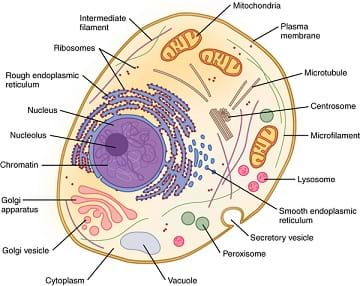Quick Look
Grade Level: 10 (9-11)
Time Required: 30 minutes
Expendable Cost/Group: US $0.00
Group Size: 1
Activity Dependency:
Subject Areas: Algebra, Biology, Chemistry, Data Analysis and Probability, Life Science, Measurement, Problem Solving, Reasoning and Proof, Science and Technology
NGSS Performance Expectations:

| HS-LS1-2 |
Summary
Students color-code a schematic of a cell and its cell membrane structures. Then they complete the "Build-a-Membrane" activity found. This reinforces their understanding of the structure and function of animal cells, and shows them the importance of being able to construct a tangible model of something that is otherwise difficult to see.
Engineering Connection
To understand intracellular engineering, students must have a basic understanding of the cell and cell mechanics. Through this activity, students take a hands-on approach by identifying and shading cell components on a cell diagram, as well as building a cell membrane model. Through this exercise, they relate building and design with science structure. Buiding models is a common approach used in the engineering design process, especially to study or manipulate objects that are at scales too difficult to see. Engineers often build models of cells to better study and understand how their structure and functions are related.
Learning Objectives
After this activity, students should be able to:
- Define the relationship between the structure and function of a cell membrane.
- Describe the different types of membrane proteins.
- Build a model cell membrane.
Educational Standards
Each TeachEngineering lesson or activity is correlated to one or more K-12 science,
technology, engineering or math (STEM) educational standards.
All 100,000+ K-12 STEM standards covered in TeachEngineering are collected, maintained and packaged by the Achievement Standards Network (ASN),
a project of D2L (www.achievementstandards.org).
In the ASN, standards are hierarchically structured: first by source; e.g., by state; within source by type; e.g., science or mathematics;
within type by subtype, then by grade, etc.
Each TeachEngineering lesson or activity is correlated to one or more K-12 science, technology, engineering or math (STEM) educational standards.
All 100,000+ K-12 STEM standards covered in TeachEngineering are collected, maintained and packaged by the Achievement Standards Network (ASN), a project of D2L (www.achievementstandards.org).
In the ASN, standards are hierarchically structured: first by source; e.g., by state; within source by type; e.g., science or mathematics; within type by subtype, then by grade, etc.
NGSS: Next Generation Science Standards - Science
| NGSS Performance Expectation | ||
|---|---|---|
|
HS-LS1-2. Develop and use a model to illustrate the hierarchical organization of interacting systems that provide specific functions within multicellular organisms. (Grades 9 - 12) Do you agree with this alignment? |
||
| Click to view other curriculum aligned to this Performance Expectation | ||
| This activity focuses on the following Three Dimensional Learning aspects of NGSS: | ||
| Science & Engineering Practices | Disciplinary Core Ideas | Crosscutting Concepts |
| Develop and use a model based on evidence to illustrate the relationships between systems or between components of a system. Alignment agreement: | Multicellular organisms have a hierarchical structural organization, in which any one system is made up of numerous parts and is itself a component of the next level. Alignment agreement: | Models (e.g., physical, mathematical, computer models) can be used to simulate systems and interactions—including energy, matter, and information flows—within and between systems at different scales. Alignment agreement: |
State Standards
Tennessee - Science
-
Construct a model of a prokaryotic or eukaryotic cell.
(Grades
9 -
12)
More Details
Do you agree with this alignment?
Materials List
Each group needs:
- colored pencils
- tape and scissors
- different colored paper
- Animal Cell Coloring Sheet, one per student, available at https://www.biologycorner.com/worksheets/cellcolor.html
To share with the entire class:
- Build-a-Membrane template and instructions, available at https://teach.genetics.utah.edu/content/cells/files/build-a-membrane.pdf
Pre-Req Knowledge
Students should have completed the associated Cell Membrane Structure and Function lesson and have a basic understanding of cell structures and their functions.
Introduction/Motivation
Ever wonder why things are arranged as they are? Is there a reason for it or are arrangements, such as cell organelles, just random?
In this activity, you will construct a cell membrane. You will also color-code a schematic of a cell and its organelles. Doing this will help you to understand where things are in a cell and why they are in specific positions.
Cells are the basis unit of life. Chemical and biomedical engineers study cells and their composition as part of designing innovative technologies to advance the medical health industry. However, cells are difficult for us to see, so engineers often build models of cells to better study and understand how their structure and functions are related.
Procedure
Background:
Nanoparticle research has become a focus in the field of biomedical engineering due to its use for drug delivery and other applications. To understand what is happening inside of the cell, students must understand how the particles enter the cell as well as its structure. A model of the cell helps students see how cell membrane structure and function, and also provides the level of detail needed by engineers to facilitate ease of entrance in their designs. First, students use colored pencils to shade in a cell diagram. As they write down the functional part of each organelle, they begin to understand placement and arrangement. Taking this a step further, students construct their own models of cell membranes. These "membrane-pieces" assemble with those from other groups in the class to form a large cell membrane model.
Before the Activity
- Gather materials and make copies of the Animal Cell Coloring Sheet, available at https://www.biologycorner.com/worksheets/cellcolor.html.
- Obtain from the University of Utah's Teach Genetics website the instructions and templates for the Build-a-Membrane activity at https://teach.genetics.utah.edu/content/cells/files/build-a-membrane.pdf. Make enough copies of the templates for all students. Either print out the instructions, or have students read them online.
With the Students
- Distribute the materials and worksheets for the cell coloring page.
- Make sure all students read the instructions carefully. This is a wonderful student-directed activity, so let them investigate and only provide instructions and guidance as they ask questions.
- Once students have completed the coloring portion, divide the class into small groups and direct them to the Build-a-Membrane exercise, following the instructions found at https://teach.genetics.utah.edu/content/cells/files/build-a-membrane.pdf.
- Conclude by assembling together the "membrane-pieces" with those from other groups in the class to form a large cell membrane model. Ask students the Investigating Questions.
Vocabulary/Definitions
cell membrane: A semi-permeable membrane that encapsulates a cell's cytoplasm.
membrane protein: A protein molecule attached to the membrane of a cell or organelle.
organelle: A structure in a cell that performs a specified task or function. Found in eukaryotic cells.
Assessment
Cell Membrane Models: At activity end, grade students on their final cell membrane product.
Investigating Questions
- What are some of the structures within a cell?
- What are their functions?
- What is nanoscience, and how does it relate to studying cells?
- Why is it important for engineers to build models of cells?
Additional Multimedia Support
Source of Animal Cell Coloring Sheet: https://www.biologycorner.com/worksheets/cellcolor.html
Source of Build-a-Membrane activity: https://teach.genetics.utah.edu/content/cells/files/build-a-membrane.pdf
Subscribe
Get the inside scoop on all things TeachEngineering such as new site features, curriculum updates, video releases, and more by signing up for our newsletter!More Curriculum Like This

Students learn about the different structures that comprise cell membranes, fulfilling part of the Research and Revise stages of the legacy cycle. They view online animations of cell membrane dynamics (links provided).

Students learn how the heart functions. They are introduced to the concept of action potential generation, which causes the electrical current that triggers muscle contraction in the heart.

Students explore the structure and function of cell membranes. As they study the ingress and egress of particles through membranes, students learn about quantum dots and biotechnology through the concept of intracellular engineering.
References
Dictionary.com. Lexico Publishing Group, LLC. Accessed June 21, 2010. http://www.dictionary.com
Copyright
© 2013 by Regents of the University of Colorado; original © 2010 Vanderbilt UniversityContributors
Melinda M. Higgins; Amber SpolarichSupporting Program
VU Bioengineering RET Program, School of Engineering, Vanderbilt UniversityAcknowledgements
The contents of this digital library curriculum were developed under National Science Foundation RET grant nos. 0338092 and 0742871. However, these contents do not necessarily represent the policies of the National Science Foundation, and you should not assume endorsement by the federal government.
Last modified: November 3, 2021








User Comments & Tips